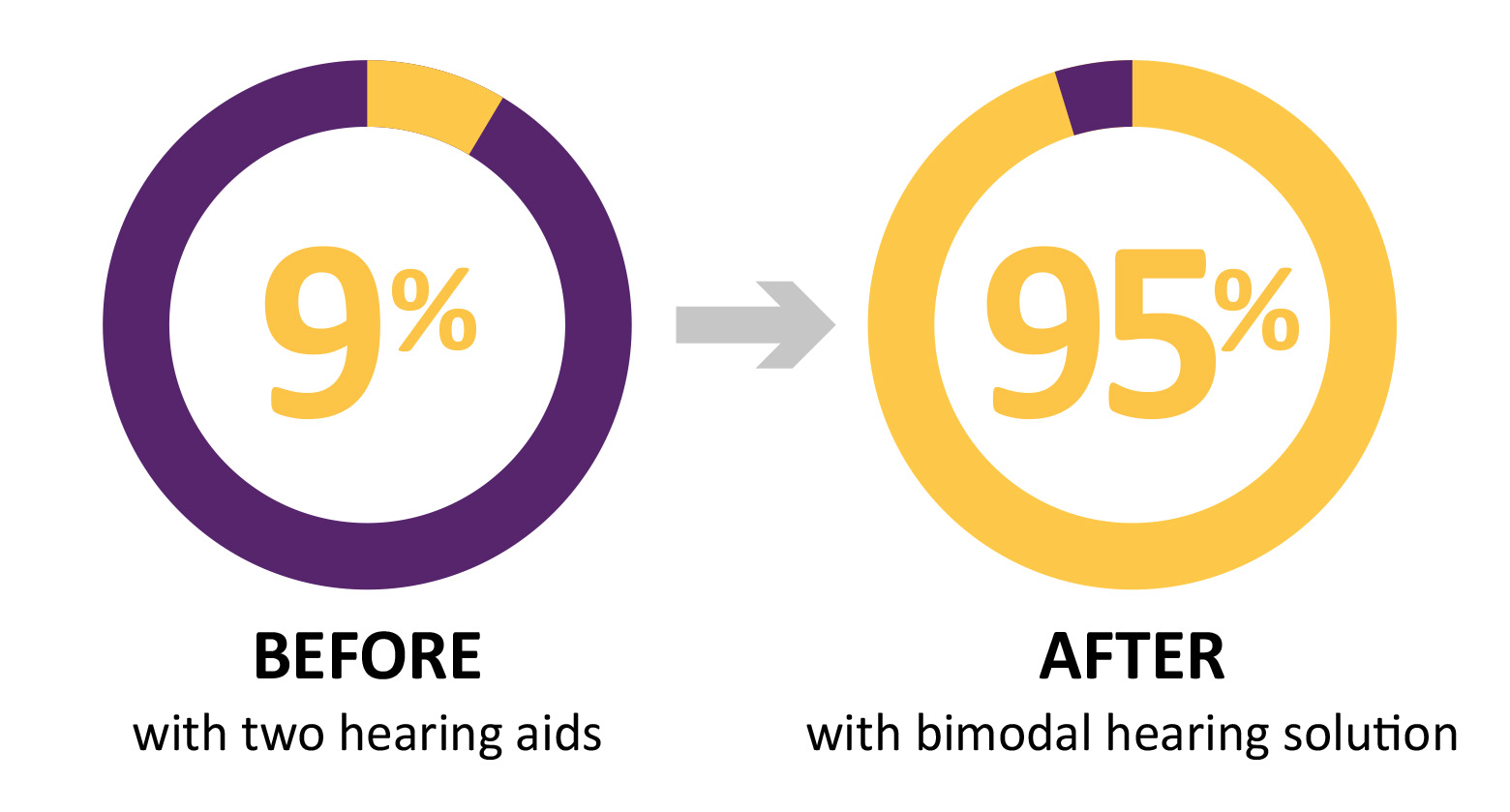
Bimodal hearing solution
Benefit from both ears.1 Discover our bimodal hearing solution that’s made for smartphones and compatible devices, from Cochlear and Danalogic.2
Two types of hearing working together
Bimodal hearing combines two types of hearing technology.
Hearing aids provide you with acoustic hearing and work by amplifying sound, so what you hear is louder. A hearing aid is designed to enhance your remaining natural hearing.
Cochlear implants bypass damaged parts of the inner ear and provide you with hearing through electrical stimulation of the hearing nerve. A cochlear implant is designed to deliver a clarity of sound your hearing aids may no longer be able to achieve.3
By optimising the hearing in both ears, bimodal hearing solutions are designed to improve overall sound quality and enhance your hearing in many situations.
Bimodal hearing satisfaction : Percentage who reported they were satisfied with their hearing performance in a study.4
Cochlear and danalogic's bimodal hearing solution
Together, Cochlear and danalogic offer a bimodal hearing solution with direct audio streaming. This means you can stream calls, music and entertainment from a compatible Apple or Android™ device directly to your compatible sound processor and hearing aid*.
Direct streaming is designed to complement your lifestyle, so you can easily connect with loved ones and the world around you.
- Designed for an accessory-free, richer hearing experience.6,10
- Direct bimodal streaming can improve speech perception on the phone compared with a hearing aid or cochlear implant alone.11
- Bluetooth® Low Energy audio streaming protocols allow minimal impact on battery life.

"Bimodal [hearing] gives me access to a range of sound which wasn’t available to me before. Direct streaming has opened up a whole world in stereo."*1
- Charlotte, bimodal hearing solution user
Connect like never beforeTo get a seamless bimodal solution, you need a:
|
The convenience of one appWith bimodal control in the Nucleus Smart App, it’s never been easier or more convenient to manage your compatible danalogic or ReSound hearing aid and Cochlear Sound Processor.* |
Additional bimodal hearing options

Bimodal hearing is available in various device combinations to help you hear your best with both ears.
A Nucleus® 8, Nucleus 7 or Kanso® 2 Sound Processor and any hearing aidYou can experience direct streaming from your compatible Apple or Android device to your Nucleus 8, Nucleus 7 or Kanso 2 Sound Processor, plus enjoy the benefits of bimodal hearing*. |
A Cochlear Sound Processor and any hearing aidWearing a Cochlear Sound Processor with any professionally fitted hearing aid on the other ear can give you the benefits of bimodal hearing. |
Disclaimer
ReSound is part of the GN group. GN makes life sound better through intelligent audio solutions.
* For compatibility information and devices visit cochlear.com/compatibility and resound.com/compatibility.
Please seek advice from your health professional about treatments for hearing loss. Outcomes may vary, and your health professional will advise you about the factors which could affect your outcome. Always follow the directions for use. Not all products are available in all countries. Please contact your local Cochlear representative for product information.
For a full list of Cochlear’s trademarks, please visit our Terms of Use page.
*1 Views expressed are those of the individual. Consult your health professional to determine if you are a candidate for Cochlear technology.
ReSound is a trademark of GN Hearing A/S.
Apple is a trademark of Apple Inc., registered in the U.S. and other countries. App Store is a service mark of Apple Inc., registered in the U.S. and other countries.
Android and Google Play are trademarks of Google LLC.
References
- Sucher CM, McDermott HJ. Bimodal stimulation: benefits for music perception and sound quality. Cochlear Implants International. 2009 Jan 1;10(S1):96-9.
- Apple Inc. 'Made for IPhone compatible hearing devices' [Internet]. Apple support. 2020 [Accessed 9 January 2020 ]. Available at: https://support.apple.com/en-us/HT210386
- Fitzpatrick EM, Leblanc S. Exploring the factors influencing discontinued hearing aid use in patients with unilateral cochlear implants. Trends in Amplification. 2010, 14; (4): 199–210.
- Buchman CA, Herzog JA, McJunkin JL, et al. Assessment of Speech Understanding After Cochlear Implantation in Adult Hearing Aid Users: A Nonrandomized Controlled Trial. JAMA Otolaryngol Head Neck Surg. Published online August 27, 2020. doi:10.1001/jamaoto.2020.1584
- Ching TY, Incerti P, Hill M. Binaural benefits for adults who use hearing aids and cochlear implants in opposite ears. Ear Hear (2004 Feb); 25, 9–21.
- Potts LG, Skinner MW, Litovsky RA., et al. Recognition and localization of speech by adult cochlear implant recipients wearing a digital hearing aid in the nonimplanted ear (bimodal hearing). J Am Acad Audiol (2009 Jun); 20, 353–373.
- Morera C, Cavalle L, Manrique M, et al. Contralateral hearing aid use in cochlear implanted patients: Multicenter study of bimodal benefit. Acta Otolaryngol (2012 Jun); 132, 1084–1094.
- Gifford RH, Dorman MF, McKarns SA, Spahr AJ. Combined electric and contralateral acoustic hearing: Word and sentence recognition with bimodal hearing. Journal of Speech, Language, and Hearing Research. (2007 Aug) 1;50(4):835-43.
- Sucher CM, McDermott HJ. Bimodal stimulation: benefits for music perception and sound quality. Cochlear Implants International. (2009 Jan); 1;10(S1):96-9.
- Neuman AC, Zeman A, Neukam J, Wang B, Svirsky MA. The effect of hearing aid bandwidth and configuration of hearing loss on bimodal speech recognition in cochlear implant users. Ear Hear. 2019;40(3):621-35.
- Wolfe J, Morais M. Speech Recognition of Bimodal Cochlear Implant Recipients Using a Wireless Audio Streaming Accessory for the Telephone Otology & Neurotology. (2016 Feb); 1;37(2):e20-5.







